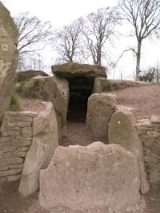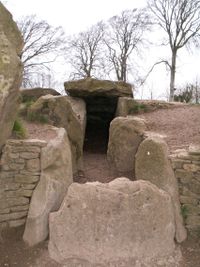
Severn-Cotswold tomb
Encyclopedia

Chamber tomb
A chamber tomb is a tomb for burial used in many different cultures. In the case of individual burials, the chamber is thought to signify a higher status for the interree than a simple grave. Built from rock or sometimes wood, the chambers could also serve as places for storage of the dead from one...
built by Neolithic
Neolithic
The Neolithic Age, Era, or Period, or New Stone Age, was a period in the development of human technology, beginning about 9500 BC in some parts of the Middle East, and later in other parts of the world. It is traditionally considered as the last part of the Stone Age...
peoples in Wales
Wales
Wales is a country that is part of the United Kingdom and the island of Great Britain, bordered by England to its east and the Atlantic Ocean and Irish Sea to its west. It has a population of three million, and a total area of 20,779 km²...
and South West England
South West England
South West England is one of the regions of England defined by the Government of the United Kingdom for statistical and other purposes. It is the largest such region in area, covering and comprising Bristol, Gloucestershire, Somerset, Dorset, Wiltshire, Devon, Cornwall and the Isles of Scilly. ...
around 3500 BC.
Description
They consist of precisely-built, long trapezoidTrapezoid
In Euclidean geometry, a convex quadrilateral with one pair of parallel sides is referred to as a trapezoid in American English and as a trapezium in English outside North America. A trapezoid with vertices ABCD is denoted...
earth mounds covering a burial chamber. Because of this they are a type of chambered long barrow
Chambered long barrow
Chambered long barrows are a type of megalithic burial monument found in the British Isles in the Neolithic.Long barrows either contained wooden or stone burial structures beneath the barrow and the surviving megalithic stone in the latter means that they are the ones referred to by archaeologists...
. In some examples, pairs of smaller burial chambers lead off from either side of the central rectangular burial chamber, itself connected to an ante-room. In others the entrance is a false entrance with the burial chambers accessed laterally from directly outside. A third group have merely a single large chamber.
Distribution
Tombs of this type are concentrated in the CotswoldsCotswolds
The Cotswolds are a range of hills in west-central England, sometimes called the Heart of England, an area across and long. The area has been designated as the Cotswold Area of Outstanding Natural Beauty...
but extend as far as Gower
Gower Peninsula
Gower or the Gower Peninsula is a peninsula in south Wales, jutting from the coast into the Bristol Channel, and administratively part of the City and County of Swansea. Locally it is known as "Gower"...
and Avebury with some isolated examples in North Wales
North Wales
North Wales is the northernmost unofficial region of Wales. It is bordered to the south by the counties of Ceredigion and Powys in Mid Wales and to the east by the counties of Shropshire in the West Midlands and Cheshire in North West England...
. Tombs of all three types are generally evenly distributed and it has been theorised that the design evolved over time. Severn-Cotswold tombs share certain features with the transepted gallery grave
Transepted gallery grave
Transepted gallery grave is a term used to describe a number of similar megalithic chamber tombs built across Atlantic Europe during the Neolithic period.It refers to burial monuments with side rooms extending laterally from a central chamber...
s of the Loire
Loire
Loire is an administrative department in the east-central part of France occupying the River Loire's upper reaches.-History:Loire was created in 1793 when after just 3½ years the young Rhône-et-Loire department was split into two. This was a response to counter-Revolutionary activities in Lyon...
and may have been inspired by these, with the lateral chambers and other differences being local variations.
In the 1960s and 1970s Dr John X. W. P. Corcoran and others argued that the group in fact consisted of three contemporary types, and later excavations have supported this.
Examples
Examples include Wayland's SmithyWayland's Smithy
Wayland's Smithy is a Neolithic long barrow and chamber tomb site located near the Uffington White Horse and Uffington Castle, at Ashbury in the English county of Oxfordshire ....
in Oxfordshire
Oxfordshire
Oxfordshire is a county in the South East region of England, bordering on Warwickshire and Northamptonshire , Buckinghamshire , Berkshire , Wiltshire and Gloucestershire ....
, West Kennet Long Barrow
West Kennet Long Barrow
The West Kennet Long Barrow is a Neolithic tomb or barrow, situated on a prominent chalk ridge, near Silbury Hill, one-and-a-half miles south of Avebury in Wiltshire, England. The site was recorded by John Aubrey in the 17th century and by William Stukeley in the 18th century.Archaeologists...
near Avebury
Avebury
Avebury is a Neolithic henge monument containing three stone circles which is located around the village of Avebury in Wiltshire, south west England. Unique amongst megalithic monuments, Avebury contains the largest stone circle in Europe, and is one of the best known prehistoric sites in Britain...
, Wiltshire
Wiltshire
Wiltshire is a ceremonial county in South West England. It is landlocked and borders the counties of Dorset, Somerset, Hampshire, Gloucestershire, Oxfordshire and Berkshire. It contains the unitary authority of Swindon and covers...
, Hetty Pegler's Tump
Uley Long Barrow
Uley Long Barrow, also known locally as "Hetty Pegler's Tump", is a Neolithic burial mound, near the village of Uley, Gloucestershire, England. Although typically described as a long barrow, the mound is actually a transected gallery grave...
, near Uley
Uley
Uley is a village in the county of Gloucestershire, England. It is situated in a wooded valley in the Cotswold escarpment, on the road between Dursley and Stroud. The population is around 1,100, but was much greater during the early years of the industrial revolution, when the village was...
, Gloucestershire
Gloucestershire
Gloucestershire is a county in South West England. The county comprises part of the Cotswold Hills, part of the flat fertile valley of the River Severn, and the entire Forest of Dean....
, and Belas Knap
Belas Knap
Belas Knap is a neolithic chambered long barrow, situated on Cleeve Hill, near Cheltenham and Winchcombe, in Gloucestershire, England. It is a scheduled ancient monument in the care of English Heritage but managed by Gloucestershire County Council. "Belas" is possibly derived from the Latin word...
, near Winchcombe
Winchcombe
Winchcombe is a Cotswold town in the local authority district of Tewkesbury, in Gloucestershire, England. Its population according to the 2001 census was 4,379.-Early history:...
, Gloucestershire. In Somerset
Somerset
The ceremonial and non-metropolitan county of Somerset in South West England borders Bristol and Gloucestershire to the north, Wiltshire to the east, Dorset to the south-east, and Devon to the south-west. It is partly bounded to the north and west by the Bristol Channel and the estuary of the...
examples include Stoney Littleton Long Barrow
Stoney Littleton Long Barrow
The Stoney Littleton Long Barrow is a Neolithic chambered tomb with multiple burial chambers, located near the village of Wellow, Somerset. It is an example of the Severn-Cotswold tomb....
and the Fairy Toot
Fairy Toot
The Fairy Toot is an extensive oval barrow in the village of Nempnett Thrubwell, Somerset, England.It is an example of the Severn-Cotswold tomb type which consist of precisely-built, long trapezoid earth mounds covering a burial chamber...
.

